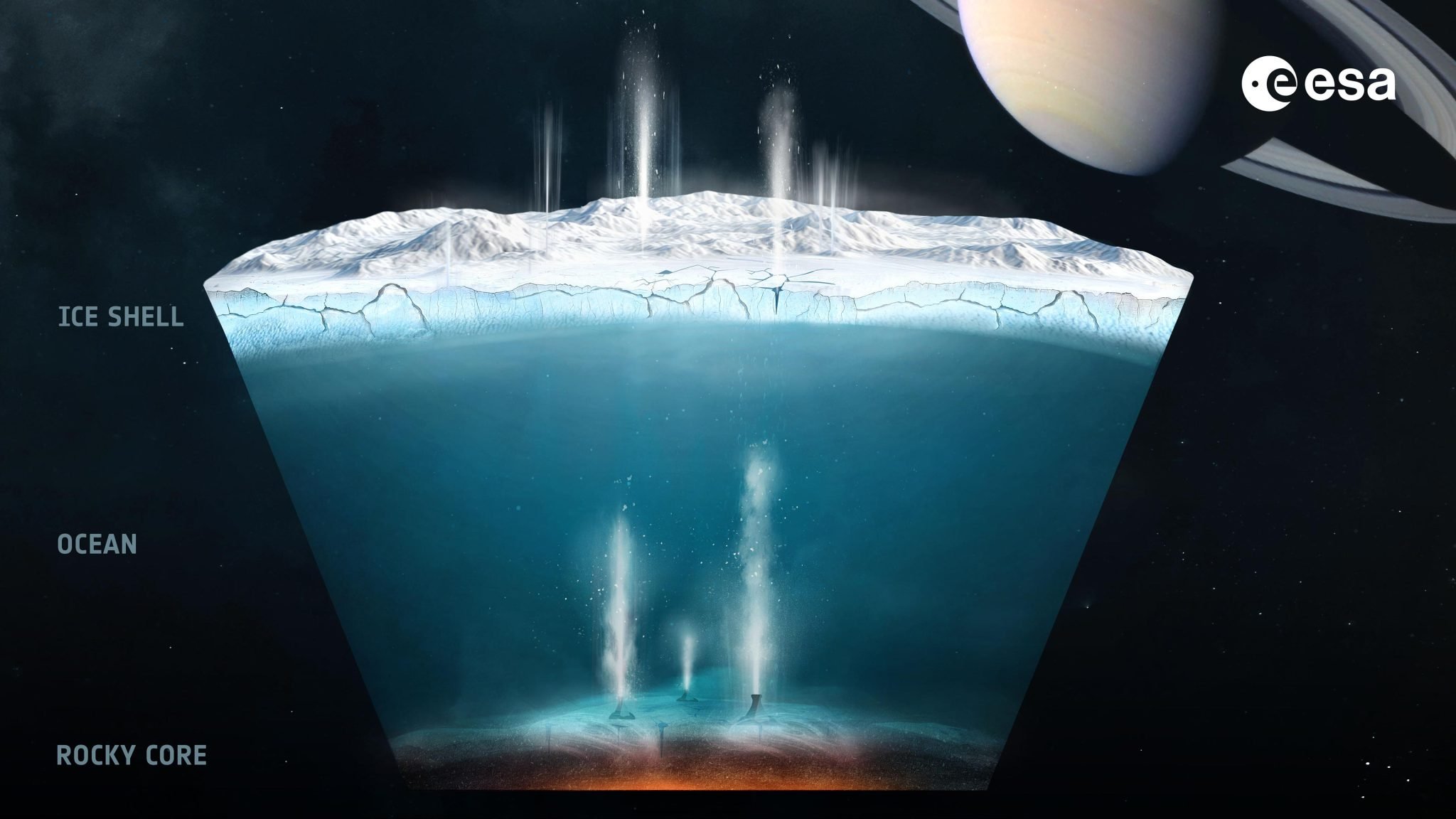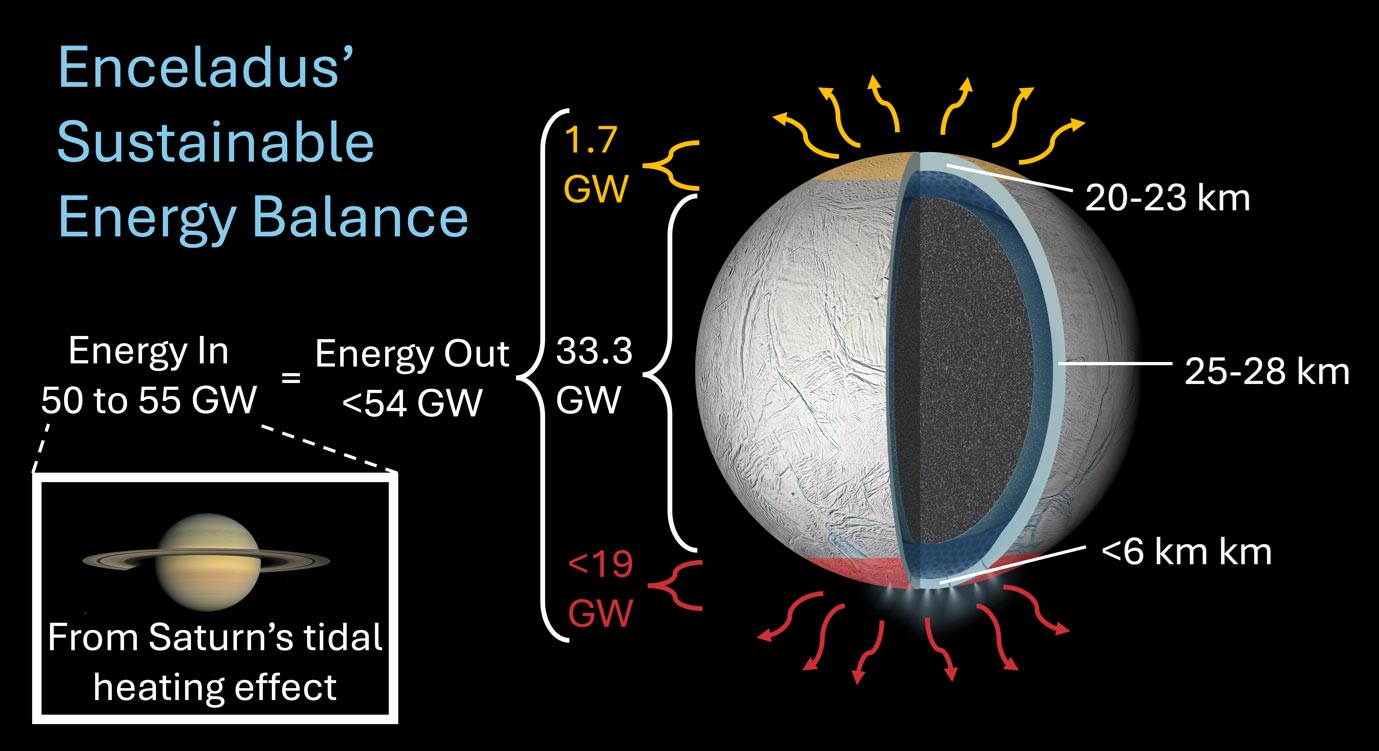👽 A cocoon for extraterrestrial life? Enceladus emits heat from both poles!
Follow us on Google News (click on ☆)
Scientists analyzed infrared data collected by the Cassini probe during the northern polar winter of 2005 and the summer of 2015. By comparing these observations, they discovered that the surface of the north pole was about 7 Kelvin degrees warmer than expected. This difference can only be explained by an internal heat source rising from the subsurface ocean through the icy crust. The detected thermal flux is equivalent to two-thirds of the heat that escapes through Earth's continental crust.

Representation of hydrothermal activity on Enceladus based on data from the Cassini-Huygens mission
Credit: ESA
This discovery revolutionizes our view of Enceladus' thermal balance. By adding the heat from the north pole to that already known from the south pole, the total energy loss reaches about 54 gigawatts. This value perfectly matches predictions of tidal heating, where Saturn's gravitational attraction deforms the moon and generates heat through internal friction. This balance suggests that the subsurface ocean could remain liquid for extremely long geological periods.
The study published in Science Advances was conducted by an international team including researchers from the University of Oxford and the Southwest Research Institute. Scientists explain that this thermal stability is essential for maintaining an environment suitable for life. Enceladus' global ocean contains liquid water, heat, and essential chemical elements like phosphorus, creating conditions similar to those of Earth's hydrothermal vents where life thrives.
The thermal data also allowed estimation of the icy crust's thickness: between 20 and 23 kilometers (12-14 miles) at the north pole and 25 to 28 kilometers (15-17 miles) on average across the entire moon. This information is valuable for future missions that might attempt to drill through this ice to reach the hidden ocean. Researchers emphasize that these discoveries were only possible thanks to Cassini's extended missions, showing the importance of long-term observations.

Study of Enceladus' global heat flow showing the balance between energy lost (north and south poles) and energy produced by tidal effect
Credit: University of Oxford/NASA/JPL-CalTech/Space Science Institute
Tidal effect, thermal engine of icy moons
The tidal effect is a physical phenomenon where the gravitational attraction of a celestial body deforms another body orbiting around it. In the case of Enceladus, Saturn's immense gravity stretches and compresses the moon cyclically during its revolution.
This permanent deformation generates internal friction within rocks and ice, producing heat through energy dissipation. This process is similar to what happens when you rapidly bend a paperclip until it heats up, but on a planetary scale.
The intensity of this heating depends on several factors: the distance between the two bodies, the eccentricity of the orbit, and the internal composition of the moon. The more elliptical the orbit and the more deformable the moon, the greater the tidal effect. This mechanism explains why some icy moons like Enceladus and Europa (around Jupiter) maintain liquid oceans despite their distance from the Sun.
On Earth, the primarily visible tidal effect concerns oceans, but on moons without atmospheres, it's the deformation of the crust itself that produces most of the heat. This process can maintain temperatures favorable to life for billions of years.
Ocean worlds of the Solar System
Ocean worlds are celestial bodies that host vast reservoirs of liquid water beneath their frozen surfaces. Enceladus is not the only example in our Solar System: Europa (Jupiter's moon), Titan, and Ganymede also have subsurface oceans.
These oceans are generally kept liquid by a combination of natural radioactive heating and tidal effects. The thick surface ice layer acts as thermal insulation, preventing the water from freezing completely. The pressure exerted by this ice can also lower water's melting point.
The composition of these oceans varies between worlds. Enceladus' ocean contains dissolved salts and organic compounds, while Europa's would be richer in sulfates. The plumes observed on Enceladus allow direct analysis of its ocean's composition without having to drill through the ice.
The discovery of these ocean worlds has radically changed our approach to the search for extraterrestrial life. Instead of only looking for planets in their star's habitable zone, scientists are now exploring these isolated but potentially hospitable environments.